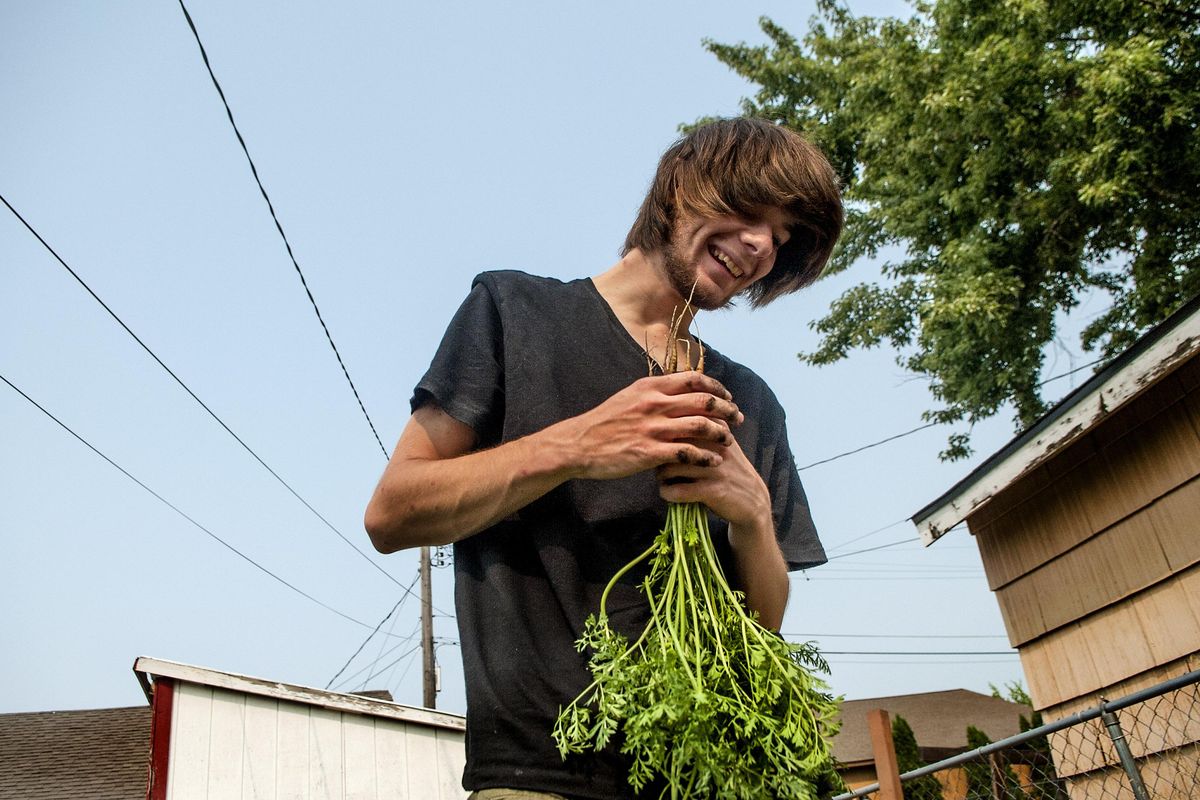New initiative seeks to grow community through urban farming

Several times a week, Christian McKinney and Brandon Gibson can be found crouched down working among beds of lettuce, carrots and other vegetables they’ve carefully nurtured in a small plot on the lawn of the Shadle Park Presbyterian Church.
But while their garden, along with a number of others scattered around the Northwest neighborhood, has cultivated a bevy of fresh produce to be sold at the Emerson-Garfield Farmers Market, volunteers like McKinney are hoping that working the rich soil will help something else sprout: a sense of community.
Part of the Growing Neighbors project, these urban farming plots make use of donated portions of people’s yards – space otherwise dedicated to non-productive patches of grass – to help bring fresh foods to an area of Spokane lacking in healthy options, said founder Johnny Edmondson. Initially planned as a restaurant concept, which Edmondson said remains a possibility down the road, the project will hopefully act as a catalyst around which community members can engage with one another, he said.
Before starting the project this spring, Edmondson said he didn’t know much about gardening – but he knew about patience.
“I’d been dreaming up a way to care for the community,” he said. “It’s been a long time coming, and things finally came together.”
Though the main goal was building community, it was important that any potential project also focus on values like feeding the hungry and stewardship of the Earth, Edmondson said.
The Growing Neighbors idea first took root at Shadle Park Presbyterian Church, where Edmondson is director of family ministries. The church planted its own community garden about three years ago, and was the first location that agreed to allow volunteers to set up shop. The program now has expanded to include 12 urban farming plots in the neighborhood and roughly 30 community volunteers, with several more residents offering up their lawns on a waiting list as demand outstripped their supply of workers, Edmondson said.
McKinney, a recent graduate from Whitworth University who works in youth programming at Shadle Park Presbyterian Church, said he’s been hearing Edmondson talk for several years about a way to bring the community together. While a lot of volunteer turnout is still tied to church events, the project has brought in children from local schools and other parts of the community, McKinney said.
“It’s been great to learn from others, and it brings a fun feel to the yard,” he said. “Gardens can be intimidating, so it’s been good encouraging people.”
One of the challenges to building community is that people have become closed off, afraid that anyone who engages them just wants something from them, McKinney said.
“There are pockets (of community), but for the most part people are pretty disconnected,” he said. “Even on my street, it’s still developing, where people are being intentional in forming community.”
By building up their local networks, people in a community can help one another instead of struggling to rely on outside organizations and services, Edmondson said.
More than just the volunteer work itself, Edmondson said he hopes the project will grow to include neighborhood walks, communal meals, and block parties. The point is to build a neighborhood family that, even going into the winter, will feel comfortable inviting one another into their homes, he said.
Though the project is still in its early stages, with volunteers like McKinney still working out technical snags like watering schedules and planting for the winter, community members say they are already beginning to feel its effects.
Dorene Hagen grew up in the Northwest neighborhood, and she decided to donate a portion of her large yard after hearing about Growing Neighbors at a neighborhood council meeting. Hagen, who is in her late 70s, runs an upholstery business out of the childhood home where she still lives and said she has fond memories of life in the neighborhood.
Hagen said she has enjoyed getting to know several of the young people who volunteered to work her plot – as well as getting to use some of the organic lettuce and tomatoes grown in her yard. Property owners can tell the volunteers what types of produce they prefer, but most residents are just happy to let the gardens grow whatever the volunteers see fit, McKinney said.
Both gardening and building community can be hard work, but McKinney said he has been impressed by what the program has harvested so far.
“No program like this takes off overnight,” he said. “But I’ve learned to appreciate the victories you get.”